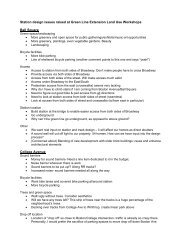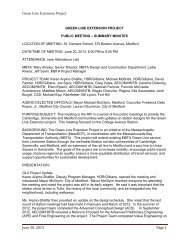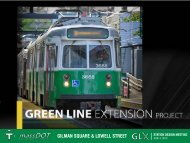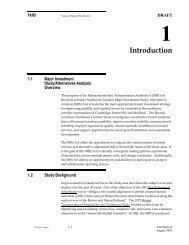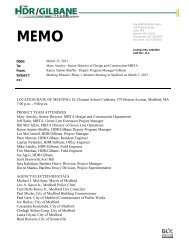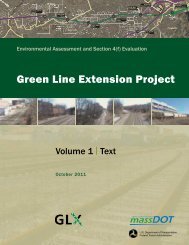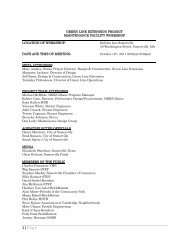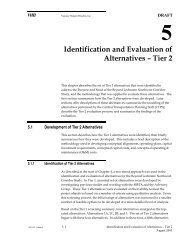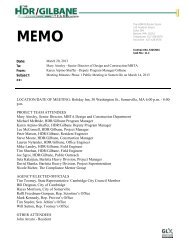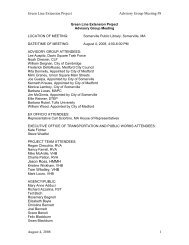Analysis of the Boston Engineering Terminal for the Purposes of ...
Analysis of the Boston Engineering Terminal for the Purposes of ...
Analysis of the Boston Engineering Terminal for the Purposes of ...
You also want an ePaper? Increase the reach of your titles
YUMPU automatically turns print PDFs into web optimized ePapers that Google loves.
Green Line Extension Project<br />
<strong>Analysis</strong> <strong>of</strong> <strong>the</strong> <strong>Boston</strong> Engine <strong>Terminal</strong><br />
<strong>for</strong><br />
The <strong>Purposes</strong> <strong>of</strong> Siting a<br />
Light Rail Vehicle Support Facility<br />
During <strong>the</strong> alternatives analysis process <strong>for</strong> <strong>the</strong> Green Line Extension project, MassDOT and <strong>the</strong> MBTA<br />
evaluated <strong>the</strong> possibility <strong>of</strong> using a portion <strong>of</strong> <strong>the</strong> site <strong>of</strong> <strong>the</strong> existing <strong>Boston</strong> Engine <strong>Terminal</strong> (BET),<br />
which serves as <strong>the</strong> maintenance facility <strong>for</strong> <strong>the</strong> MBTA Commuter Rail fleet, <strong>for</strong> <strong>the</strong> construction <strong>of</strong> a<br />
new light rail vehicle support facility. The construction <strong>of</strong> such a facility is required <strong>for</strong> <strong>the</strong> successful<br />
implementation <strong>of</strong> <strong>the</strong> Green Line Extension project. The ‘BET concept’ was embraced by a number <strong>of</strong><br />
project stakeholders, who felt that <strong>the</strong> conjoining <strong>of</strong> two MBTA vehicle support facilities would be<br />
preferable to <strong>the</strong> construction <strong>of</strong> a second, separate light rail support facility. In addition, some<br />
stakeholders sought to avoid <strong>the</strong> commercial property impacts required <strong>for</strong> <strong>the</strong> ‘Option L’ location, <strong>the</strong><br />
location preferred and recommended by MassDOT and <strong>the</strong> MBTA. While MassDOT and <strong>the</strong> MBTA had,<br />
as part <strong>of</strong> <strong>the</strong> original alternatives analysis, considered and rejected <strong>the</strong> BET site as a viable alternative,<br />
MassDOT and <strong>the</strong> MBTA agreed to re‐examine <strong>the</strong> issue.<br />
The purpose <strong>of</strong> this white paper is to re‐examine, in more depth, <strong>the</strong> ramifications <strong>of</strong> making use <strong>of</strong> a<br />
portion <strong>of</strong> <strong>the</strong> current BET site – ei<strong>the</strong>r in conjunction with all <strong>of</strong> <strong>the</strong> current elements <strong>of</strong> <strong>the</strong> BET facility<br />
or by relocating certain elements – to construct a new light rail vehicle maintenance and storage facility<br />
that can support <strong>the</strong> Green Line Extension project. The paper provides an overview <strong>of</strong> <strong>the</strong> current BET<br />
site and operations, <strong>the</strong> functional and geographic needs <strong>of</strong> <strong>the</strong> new light rail support facility, and <strong>the</strong><br />
overwhelming challenges <strong>of</strong> trying to co‐locate <strong>the</strong> two vehicle support facilities on <strong>the</strong> existing BET site.<br />
This paper has been structured around a series <strong>of</strong> core questions related to <strong>the</strong> location <strong>of</strong> a light rail<br />
vehicle support facility within <strong>the</strong> existing BET site.<br />
Additionally, this white paper serves to provide some background on <strong>the</strong> need <strong>for</strong> a light rail vehicle<br />
maintenance facility and <strong>the</strong> importance <strong>of</strong> siting <strong>the</strong> facility within <strong>the</strong> Green Line Extension corridor.<br />
1. Why does <strong>the</strong> light rail vehicle support facility need to accommodate 70‐80 vehicles when only 24<br />
new Green Line vehicles are needed to make <strong>the</strong> Green Line Extension operate?<br />
When planning a new transit service or extension <strong>of</strong> existing transit service, <strong>the</strong>re are many important<br />
factors that influence <strong>the</strong> siting and design <strong>of</strong> a new vehicle maintenance facility, including its necessary<br />
size, orientation, location, proximity to <strong>the</strong> service, costs, operational impacts, impacts to abutting<br />
communities and natural resources, as well as o<strong>the</strong>rs. Understanding current maintenance capacity<br />
constraints well as <strong>the</strong> impact that a new service will have on <strong>the</strong> existing maintenance system is also<br />
critical.<br />
The existing Green Line vehicle fleet is currently stored at <strong>the</strong> following facilities: Reservoir (in<br />
Brookline), Riverside (in Newton), Lake Street (in Brighton), and Lechmere (in East Cambridge).
Green Line Extension Project<br />
<strong>Analysis</strong> <strong>of</strong> <strong>the</strong> <strong>Boston</strong> Engine <strong>Terminal</strong> <strong>for</strong> <strong>the</strong> <strong>Purposes</strong> <strong>of</strong> Siting a Light Rail Vehicle Support Facility<br />
Maintenance support is only available at <strong>the</strong> Reservoir, Riverside and Lake Street facilities, all located on<br />
<strong>the</strong> west end <strong>of</strong> <strong>the</strong> Green Line system. There are currently no maintenance facilities located on <strong>the</strong><br />
nor<strong>the</strong>ast side <strong>of</strong> <strong>the</strong> system in proximity to <strong>the</strong> proposed corridor <strong>of</strong> <strong>the</strong> Green Line Extension project.<br />
The existing facilities are operating beyond <strong>the</strong>ir planned capacity and expansion <strong>of</strong> <strong>the</strong>se facilities to<br />
accommodate <strong>the</strong> Green Line Extension project is impractical in terms <strong>of</strong> logistics, service reliability and<br />
operating costs. In fact, until very recently, vehicles were stored in <strong>the</strong> subway tunnel tracks at <strong>the</strong><br />
Brattle Loop in Government Center so as to alleviate overcrowding at <strong>the</strong> existing storage facilities. In<br />
order to balance operations, <strong>the</strong>se vehicles should be stored on <strong>the</strong> nor<strong>the</strong>ast side <strong>of</strong> <strong>the</strong> Green Line so<br />
as to have sufficient storage capacity on both ends <strong>of</strong> <strong>the</strong> system. Negative impacts to <strong>the</strong> operations <strong>of</strong><br />
<strong>the</strong> Green Line caused <strong>the</strong> MBTA to cease using <strong>the</strong> Brattle Loop as a storage location; those vehicles are<br />
now stored at Riverside and Reservoir, <strong>the</strong>reby exacerbating an already overcrowded condition.<br />
The following table compares <strong>the</strong> number <strong>of</strong> vehicles each facility is designed to accommodate and to<br />
<strong>the</strong> number <strong>of</strong> vehicles currently stored at each facility:<br />
Storage Facility<br />
Design<br />
Capacity<br />
# <strong>of</strong> Vehicles<br />
Stored<br />
Reservoir 90 102<br />
Riverside 51 62<br />
Lake Street 22 25<br />
Lechmere 17 20<br />
TOTAL 180 209<br />
The entire MBTA system currently includes a total overnight storage capacity <strong>of</strong> 180 cars, while <strong>the</strong><br />
current fleet totals 209 cars. The identified storage capacity <strong>for</strong> revenue cars assumes free movement<br />
about <strong>the</strong> yard. In order to accommodate <strong>the</strong> present fleet, which exceeds <strong>the</strong> calculated capacity, cars<br />
are stored on active servicing and switching tracks at <strong>the</strong>se facilities. This type <strong>of</strong> storage complicates<br />
and delays servicing and maintenance operations. For example, <strong>the</strong> Lechmere Loop is used to store 20<br />
cars, as compared to its capacity <strong>of</strong> 17, <strong>the</strong>reby blocking <strong>the</strong> station tracks. This situation is fur<strong>the</strong>r<br />
exacerbated by <strong>the</strong> need to accommodate non‐revenue cars, specifically maintenance and construction<br />
rail cars. Simply stated, <strong>the</strong> existing facilities are operating beyond <strong>the</strong>ir intended capacity and, thusly,<br />
do not allow <strong>for</strong> any additional service expansions to <strong>the</strong> Green Line system.<br />
As <strong>the</strong> only vehicle support facility located on <strong>the</strong> nor<strong>the</strong>ast side <strong>of</strong> Green Line system, Lechmere Station<br />
requires special discussion here. There are currently 20 Green Line cars stored at Lechmere Station.<br />
These cars, plus <strong>the</strong> 14 cars which were previously stored within <strong>the</strong> Brattle Loop, must be relocated to<br />
enable <strong>the</strong> implementation <strong>of</strong> <strong>the</strong> Green Line Extension project (with <strong>the</strong> construction <strong>of</strong> <strong>the</strong> Green Line<br />
Extension, <strong>the</strong> Brattle Loop will no longer be available to <strong>the</strong> MBTA <strong>for</strong> vehicle storage). In addition, and<br />
in order to accommodate <strong>the</strong> level <strong>of</strong> service anticipated on both branches <strong>of</strong> <strong>the</strong> Green Line Extension,<br />
<strong>the</strong> MBTA plans to purchase an additional 24 Green Line vehicles. These new vehicles must also be<br />
accommodated at <strong>the</strong> new light rail vehicle support facility on <strong>the</strong> day <strong>the</strong> Green Line Extension<br />
becomes operational.<br />
The MBTA must also think about <strong>the</strong> potential <strong>for</strong> future growth on <strong>the</strong> nor<strong>the</strong>ast side <strong>of</strong> <strong>the</strong> Green Line<br />
system. As <strong>the</strong> demand <strong>for</strong> Green Line service in <strong>the</strong> Somerville‐Med<strong>for</strong>d corridor increases over time,<br />
Prepared by MassDOT/MBTA<br />
March 2011<br />
Page 2
Green Line Extension Project<br />
<strong>Analysis</strong> <strong>of</strong> <strong>the</strong> <strong>Boston</strong> Engine <strong>Terminal</strong> <strong>for</strong> <strong>the</strong> <strong>Purposes</strong> <strong>of</strong> Siting a Light Rail Vehicle Support Facility<br />
additional vehicles may be needed. In addition, future projects may fur<strong>the</strong>r extend <strong>the</strong> Green Line to<br />
Route 16/Mystic Valley Parkway or to a connection at Porter Square. These expansions would require<br />
additional vehicles and <strong>the</strong>re<strong>for</strong>e additional space at a storage and maintenance facility. A reasonable<br />
planning approach is to size <strong>the</strong> facility with those types <strong>of</strong> future needs in mind; to fail to plan <strong>for</strong> <strong>the</strong>se<br />
future developments would limit our ability in <strong>the</strong> future to make <strong>the</strong>se improvements.<br />
In light <strong>of</strong> all <strong>of</strong> <strong>the</strong>se realities, <strong>the</strong> MBTA is planning, as part <strong>of</strong> <strong>the</strong> GLX project, to build a light rail<br />
support facility to accommodate 70‐80 vehicles. While <strong>the</strong> MBTA may, as part <strong>of</strong> <strong>the</strong> engineering<br />
process, ultimately reduce <strong>the</strong> proposed size <strong>of</strong> <strong>the</strong> facility somewhat, we believe at this point that it is<br />
prudent to plan <strong>for</strong> a facility <strong>of</strong> this size.<br />
2. Why is a new maintenance facility needed? Why can’t <strong>the</strong> existing Green Line vehicle support<br />
facilities be expanded to accommodate <strong>the</strong> vehicles proposed to be stored in <strong>the</strong> new facility?<br />
The MBTA requires a Green Line support facility that would serve <strong>the</strong> proposed Green Line Extension to<br />
Med<strong>for</strong>d and Union Square <strong>for</strong> <strong>the</strong> purposes <strong>of</strong>:<br />
<br />
<br />
<br />
<br />
Storage <strong>of</strong> Green Line cars;<br />
Inspection, light maintenance and repair <strong>of</strong> Green Line cars;<br />
Provision <strong>of</strong> a base <strong>for</strong> <strong>the</strong> maintenance and repair <strong>of</strong> <strong>the</strong> track, power, and signals systems <strong>for</strong><br />
<strong>the</strong> Extension; and<br />
To address <strong>the</strong> current shortage <strong>of</strong> Green Line Storage on <strong>the</strong> nor<strong>the</strong>ast side.<br />
For <strong>the</strong> Green Line Extension to operate efficiently and cost‐effectively, it is essential to store a number<br />
<strong>of</strong> Green Line vehicles on <strong>the</strong> nor<strong>the</strong>ast side <strong>of</strong> <strong>the</strong> MBTA Green Line network in order to provide cars<br />
<strong>for</strong> morning start‐up, to provide a convenient location <strong>for</strong> overnight and <strong>of</strong>f‐peak storage as cars come<br />
out <strong>of</strong> service, and to minimize <strong>the</strong> distance a disabled train has to travel to reach a support facility.<br />
Without a nor<strong>the</strong>ast‐side facility, <strong>the</strong> MBTA would need to o<strong>the</strong>rwise move cars to <strong>the</strong> west‐side<br />
facilities each night and back to <strong>the</strong> nor<strong>the</strong>ast in <strong>the</strong> early morning, which could interfere with critical<br />
overnight maintenance work <strong>for</strong> track, signal, and power systems. Additionally, car storage is not only<br />
required <strong>for</strong> <strong>the</strong> overnight storage <strong>of</strong> cars but also <strong>for</strong> day‐time storage between <strong>the</strong> morning and<br />
evening peak hours. Fur<strong>the</strong>rmore, when a Green Line car becomes disabled, it is essential that <strong>the</strong> car<br />
be moved to <strong>the</strong> closest support facility to get it out <strong>of</strong> <strong>the</strong> way <strong>of</strong> revenue service trains and to a<br />
location where it can be properly serviced. In order to provide transit service on <strong>the</strong> Green Line<br />
Extension that is reliable, cost‐efficient, and does not adversely impact <strong>the</strong> remainder <strong>of</strong> <strong>the</strong> Green Line<br />
system – that effectively leverages <strong>the</strong> investment represented by <strong>the</strong> Extension project – it is necessary<br />
that a vehicle support facility be provided on <strong>the</strong> nor<strong>the</strong>ast side <strong>of</strong> <strong>the</strong> system.<br />
Of critical concern is <strong>the</strong> ability to adequately store and service vehicles as part <strong>of</strong> <strong>the</strong> daily operating<br />
routine. Appropriate vehicle storage is vital <strong>for</strong> service quality, reliability, and operating costs <strong>for</strong> both<br />
existing and any new services.<br />
With <strong>the</strong> proposed Extension in place, it would be impractical to depend on <strong>the</strong> existing west‐side<br />
support facilities (Riverside, Reservoir, and Lake Street). Without a nor<strong>the</strong>ast‐side support facility it<br />
would be necessary to:<br />
Prepared by MassDOT/MBTA<br />
March 2011<br />
Page 3
Green Line Extension Project<br />
<strong>Analysis</strong> <strong>of</strong> <strong>the</strong> <strong>Boston</strong> Engine <strong>Terminal</strong> <strong>for</strong> <strong>the</strong> <strong>Purposes</strong> <strong>of</strong> Siting a Light Rail Vehicle Support Facility<br />
<br />
<br />
<br />
“Dead‐head” cars from Newton to Med<strong>for</strong>d Hillside and Union Square <strong>for</strong> <strong>the</strong> morning start <strong>of</strong><br />
service;<br />
“Dead‐head” cars from Med<strong>for</strong>d Hillside and Union Square back to Newton <strong>for</strong> <strong>the</strong> nighttime<br />
end <strong>of</strong> service;<br />
Tow or push cars that become disabled nor<strong>the</strong>ast <strong>of</strong> Lechmere back through <strong>the</strong> entire length <strong>of</strong><br />
<strong>the</strong> Central Subway which will have an impact on Green Line operations. .<br />
The long travel times would add to operating costs and lack <strong>of</strong> operational flexibility (e.g., <strong>the</strong> ability to<br />
add a car in service to replace a disabled car), all translating into less reliable service <strong>for</strong> <strong>the</strong> MBTA’s<br />
patrons <strong>of</strong> <strong>the</strong> Green Line. Negative impacts associated with increased dead‐heading are:<br />
<br />
<br />
<br />
<br />
Operating costs, such as maintenance and transportation;<br />
Additional “wear and tear” on vehicles and track infrastructure;<br />
Noise impacts in <strong>the</strong> early morning and evening;<br />
Limits on time available <strong>for</strong> critical infrastructure and vehicle maintenance.<br />
There<strong>for</strong>e, it is essential to store a number <strong>of</strong> cars on <strong>the</strong> nor<strong>the</strong>ast‐side <strong>of</strong> <strong>the</strong> proposed Green Line<br />
Extension, in order to provide cars <strong>for</strong> start‐up in <strong>the</strong> morning, provide a convenient location <strong>for</strong><br />
overnight and <strong>of</strong>f‐peak storage as cars come out <strong>of</strong> service, and minimize <strong>the</strong> distance a disabled train<br />
has to travel to reach a support facility. This will also eliminate much <strong>of</strong> <strong>the</strong> need to o<strong>the</strong>rwise move cars<br />
to <strong>the</strong> west‐side facilities each night and back to <strong>the</strong> Med<strong>for</strong>d and Union Square termini in <strong>the</strong> early<br />
morning, which could interfere with critical overnight maintenance work <strong>for</strong> track, signal, and power<br />
systems.<br />
Due to insufficient storage and maintenance capacity at Lechmere, MBTA Green Line Operations<br />
currently moves four cars twice daily between Reservoir and Lechmere. These trains are operated in<br />
revenue service from Reservoir onto <strong>the</strong> Heath St.‐Lechmere E Line route (termed “revenue deadheading”)<br />
and <strong>the</strong>n remain in service on <strong>the</strong> E Line route. However, if Lechmere provided sufficient<br />
storage <strong>for</strong> <strong>the</strong> four “Reservoir cars” and <strong>the</strong> 14 cars previously stored on <strong>the</strong> Brattle Loop, Green Line<br />
Operations would avoid approximately $50,000 annually, as well as an extra 20,000 miles per year, in<br />
“dead‐heading” costs.<br />
As shown in <strong>the</strong> table below, <strong>the</strong> travel time from Lechmere Station to <strong>the</strong> west‐end support yards<br />
would range from 38 minutes to 1 hour. An additional 5 to 9.5 minutes travel time is required between<br />
Union Square or College Avenue and Lechmere. There<strong>for</strong>e, without a nor<strong>the</strong>ast‐end support facility:<br />
It would take 50 to 70 minutes <strong>for</strong> a train coming out <strong>of</strong> service at College Avenue to “dead‐head”<br />
back to a west‐side yard;<br />
It would take 50 to 72 minutes <strong>for</strong> a train coming out <strong>of</strong> service at Mystic Valley Parkway/Route 16<br />
(if this option is implemented in <strong>the</strong> future) to “dead‐head” back to a west‐side yard;<br />
It would take considerably longer to tow or push a disabled train over <strong>the</strong>se routes at “restricted<br />
speed,” <strong>the</strong>reby slowing down <strong>the</strong> Green Line service. This delay cascades through <strong>the</strong> system and<br />
causes extensive delays which can be particularly difficult in <strong>the</strong> rush hour.<br />
Prepared by MassDOT/MBTA<br />
March 2011<br />
Page 4
Green Line Extension Project<br />
<strong>Analysis</strong> <strong>of</strong> <strong>the</strong> <strong>Boston</strong> Engine <strong>Terminal</strong> <strong>for</strong> <strong>the</strong> <strong>Purposes</strong> <strong>of</strong> Siting a Light Rail Vehicle Support Facility<br />
Location<br />
North <strong>of</strong> Lechmere<br />
Route<br />
College Avenue to<br />
Lechmere<br />
Peak Hour Travel Time<br />
9.5 min.<br />
North <strong>of</strong> Lechmere Mystic Valley to Lechmere 12 min<br />
Union Square to<br />
Lechmere<br />
5 min.<br />
West <strong>of</strong> Lechmere Lechmere to Riverside 60 min.<br />
Lechmere to Reservoir via<br />
Beacon Street<br />
Lechmere to Reservoir via<br />
Highland Branch<br />
Lechmere to Lake St.<br />
48 min.<br />
38 min.<br />
56 min.<br />
3. Can <strong>the</strong> existing BET site be used as a location <strong>for</strong> <strong>the</strong> Green Line Maintenance Facility?<br />
The MBTA’s <strong>Boston</strong> Engine <strong>Terminal</strong> (BET) Commuter Rail Maintenance Facility includes a large<br />
maintenance building surrounded by yard tracks, parking, and material storage areas. The BET was<br />
constructed in 1997 to serve as <strong>the</strong> main repair, maintenance, and inspection facility <strong>for</strong> <strong>the</strong> MBTA’s<br />
commuter rail system. The building was constructed on <strong>the</strong> site <strong>of</strong> <strong>the</strong> <strong>for</strong>mer BET, which has been in<br />
railroad use since <strong>the</strong> mid‐nineteenth century. Some Green Line Extension project stakeholders have<br />
suggested that <strong>the</strong> BET appears to be underutilized; that is, that <strong>the</strong>re appears to be significant extra<br />
(un‐used) land area at <strong>the</strong> BET that could be used to accommodate a Green Line vehicle maintenance<br />
facility. The BET is, however, not an underutilized space. When <strong>the</strong> facility first opened in 1997, <strong>the</strong><br />
commuter rail coach fleet numbered 363. Since construction, commuter rail service has been<br />
inaugurated on <strong>the</strong> three Old Colony Lines and service enhancements and fleet expansions continue to<br />
be implemented throughout <strong>the</strong> commuter rail system. As a result, <strong>the</strong> facility is now responsible <strong>for</strong><br />
supporting <strong>the</strong> operations <strong>of</strong> a fleet <strong>of</strong> 410 coaches, as well as a fleet <strong>of</strong> 83 locomotives. As a result <strong>of</strong><br />
<strong>the</strong> continued expansion in commuter rail services, <strong>the</strong> facility is operating at or beyond capacity.<br />
Some stakeholders have also commented that <strong>the</strong> outside storage yards at BET appear to be<br />
underutilized. The yards, however, are well used during <strong>the</strong> day (between <strong>the</strong> AM peak period and <strong>the</strong><br />
PM peak period), when trains are frequently queued up to go in and out <strong>of</strong> <strong>the</strong> maintenance facility <strong>for</strong><br />
service. The storage yards are also used to store trains not needed <strong>for</strong> midday service. The yard tracks,<br />
in <strong>the</strong>ir current configuration, are a critical element <strong>of</strong> <strong>the</strong> BET functionality. Only some trains are<br />
stored at <strong>the</strong> BET yards at night, since most trains are stored overnight at remote layover facilities at <strong>the</strong><br />
end <strong>of</strong> <strong>the</strong> commuter rail lines. During <strong>the</strong> day, however, <strong>the</strong> entirety <strong>of</strong> <strong>the</strong> BET facility is heavily used<br />
and critical to MBTA operations.<br />
Prepared by MassDOT/MBTA<br />
March 2011<br />
Page 5
Green Line Extension Project<br />
<strong>Analysis</strong> <strong>of</strong> <strong>the</strong> <strong>Boston</strong> Engine <strong>Terminal</strong> <strong>for</strong> <strong>the</strong> <strong>Purposes</strong> <strong>of</strong> Siting a Light Rail Vehicle Support Facility<br />
Figure 1: MBTA BET Commuter Rail Facility Tracks<br />
The BET is a large facility which per<strong>for</strong>ms multiple maintenance, repair, inspection, and storage<br />
functions <strong>for</strong> <strong>the</strong> MBTA commuter rail fleet, including both <strong>the</strong> nor<strong>the</strong>ast‐side and south‐side services.<br />
The current facility as shown in Figure 1 includes <strong>the</strong> following:<br />
a. Maintenance Building and Lead Tracks<br />
The maintenance building floor plate can be divided into <strong>the</strong> component functions in each area as<br />
shown in Figure 1, starting at <strong>the</strong> nor<strong>the</strong>ast end:<br />
The shops per<strong>for</strong>m repairs on components removed from coaches and locomotives. The stores<br />
contain spare parts and equipment used in repair work.<br />
Truck repairs include bays with lifts where coaches and locomotives can be lifted so that <strong>the</strong> trucks<br />
(<strong>the</strong> wheel assembly) can be removed <strong>for</strong> repairs or replacement.<br />
Coach repairs include bays where <strong>the</strong> coaches receive major repair work.<br />
Locomotive repairs include bays where repairs are made to <strong>the</strong> four types <strong>of</strong> locomotives used <strong>for</strong><br />
revenue service.<br />
The periodic inspection bays include pits where a train can be inspected.<br />
The service and repair bays are <strong>for</strong> regularly scheduled servicing and minor repair work.<br />
b. Storage, Layover, and Lay‐up Tracks<br />
There are five tracks south <strong>of</strong> <strong>the</strong> maintenance building used <strong>for</strong> temporary storage, layover, or lay‐up <strong>of</strong><br />
commuter rail equipment. Temporary storage includes coaches awaiting service, inspection, and/or<br />
repair work at <strong>the</strong> maintenance building. Layover refers to overnight storage <strong>of</strong> train sets. Lay‐up refers<br />
to storage <strong>of</strong> train sets between runs. More trains reach North Station in <strong>the</strong> morning peak hours than<br />
are needed until afternoon peak hours. Excess equipment is stored on <strong>the</strong> lay‐up tracks.<br />
Prepared by MassDOT/MBTA<br />
March 2011<br />
Page 6
Green Line Extension Project<br />
<strong>Analysis</strong> <strong>of</strong> <strong>the</strong> <strong>Boston</strong> Engine <strong>Terminal</strong> <strong>for</strong> <strong>the</strong> <strong>Purposes</strong> <strong>of</strong> Siting a Light Rail Vehicle Support Facility<br />
c. Valley Tracks<br />
There are four tracks in a crescent alignment to <strong>the</strong> west <strong>of</strong> <strong>the</strong> maintenance building, known as <strong>the</strong><br />
“Valley Tracks” (as <strong>the</strong>y appear to be in a valley between <strong>the</strong> elevated MBTA Lowell commuter rail Line<br />
to <strong>the</strong> north and <strong>the</strong> embankment <strong>of</strong> <strong>the</strong> Yard 8 and Yard 7 tracks approaching Red Bridge to <strong>the</strong> south).<br />
These tracks connect to <strong>the</strong> Fitchburg Line and Grand Junction Branch to <strong>the</strong> south and to <strong>the</strong> Eastern<br />
and Western Main Lines to <strong>the</strong> north. They are not used <strong>for</strong> MBTA revenue commuter rail operations.<br />
However, <strong>the</strong>y are <strong>the</strong> principal operating routes <strong>for</strong> freight movements by both CSX and Pan Am<br />
Railways (PAR, <strong>for</strong>merly Guil<strong>for</strong>d Rail System). The Valley Tracks are part <strong>of</strong> CSX’s Grand Junction Branch<br />
from Beacon Park Yard in Allston to Everett and typically sees one round‐trip per day between <strong>the</strong>se end<br />
points.<br />
The Valley Tracks are a key node <strong>for</strong> PAR’s freight operations. PAR operates up to four to six trains daily,<br />
including <strong>the</strong> “gravel train” serving <strong>Boston</strong> Sand and Gravel near <strong>the</strong> BET and local freight serving all<br />
customers from <strong>Boston</strong> to Peabody via <strong>the</strong> Eastern Route. These trains travel east through <strong>the</strong> Valley<br />
Tracks to reach <strong>the</strong> Eastern Route, next to I‐93. PAR also parks its <strong>Boston</strong>‐based locomotives on <strong>the</strong><br />
Valley Tracks.<br />
The MBTA uses <strong>the</strong> Valley Tracks to park its maintenance‐<strong>of</strong>‐way (MOW) trains, as well as <strong>for</strong> some<br />
movements into and out <strong>of</strong> <strong>the</strong> maintenance facility.<br />
d. Fitchburg Line Tracks<br />
South <strong>of</strong> <strong>the</strong> layover and lay‐up tracks are <strong>the</strong> two Fitchburg Line tracks, used <strong>for</strong> all commuter rail<br />
revenue service on <strong>the</strong> MBTA Fitchburg Line. These tracks are separated from <strong>the</strong> yard tracks by a<br />
fence.<br />
e. Employee Parking Lot<br />
The 242‐space employee parking lot is located northwest <strong>of</strong> <strong>the</strong> maintenance building and serves both<br />
BET employees and visitors.<br />
4. How Could a Green Line Vehicle Support Facility Be Added to BET?<br />
There are three families <strong>of</strong> scenarios that could be considered <strong>for</strong> adding a Green Line vehicle storage<br />
facility to <strong>the</strong> current BET facility. Each <strong>of</strong> <strong>the</strong>se scenarios has various challenges and consequences,<br />
which are described below. These categories include:<br />
Joint Use <strong>of</strong> <strong>the</strong> existing BET facility, in which <strong>the</strong> commuter rail maintenance bays, storage<br />
tracks, and equipment are also used by Green Line vehicles.<br />
Dedicated Green Line Facilities at <strong>the</strong> existing site, which would require creating dedicated<br />
space <strong>for</strong> Green Line vehicles at <strong>the</strong> existing BET site, including separate maintenance bays and<br />
storage tracks. Any infrastructure to be used by Green Line vehicles would need to be fully<br />
segregated from any commuter rail infrastructure. In this category, some <strong>of</strong> <strong>the</strong>se scenarios<br />
require <strong>the</strong> reduction and relocation <strong>of</strong> existing commuter rail activities at <strong>the</strong> BET, while o<strong>the</strong>rs<br />
would not.<br />
Prepared by MassDOT/MBTA<br />
March 2011<br />
Page 7
Green Line Extension Project<br />
<strong>Analysis</strong> <strong>of</strong> <strong>the</strong> <strong>Boston</strong> Engine <strong>Terminal</strong> <strong>for</strong> <strong>the</strong> <strong>Purposes</strong> <strong>of</strong> Siting a Light Rail Vehicle Support Facility<br />
<br />
Relocation <strong>of</strong> some or all <strong>of</strong> <strong>the</strong> existing BET commuter rail operations to a new site to<br />
accommodate <strong>the</strong> construction <strong>of</strong> a Green Line vehicle support facility at <strong>the</strong> current BET site.<br />
a. Joint Use <strong>of</strong> Existing BET Facility<br />
This option requires Green Line vehicles to share <strong>the</strong> existing BET facilities, including storage tracks and<br />
maintenance bays, with commuter rail equipment. To determine if this is a feasible option, it is<br />
important to review safety and capacity requirements at <strong>the</strong> site, as well as operations and staffing<br />
capabilities.<br />
In rail operations, safety is always <strong>the</strong> most important consideration. The safety <strong>of</strong> a transit system is<br />
conditional on many factors, one <strong>of</strong> which is <strong>the</strong> operating characteristics <strong>of</strong> <strong>the</strong> transit vehicle. Most<br />
urban rail transit systems, such as <strong>the</strong> MBTA, operate isolated from <strong>the</strong> FRA‐regulated railway system.<br />
With <strong>the</strong> MBTA, each <strong>of</strong> <strong>the</strong> four lines (Red, Blue, Orange, and Green) is, in effect a “closed track” where<br />
each line’s cars operate only with similar cars on its own line. There is no interoperation between lines.<br />
For example, <strong>the</strong> Green Line cars remain on <strong>the</strong> tracks <strong>of</strong> <strong>the</strong> Green Line and do not use <strong>the</strong> tracks <strong>of</strong> <strong>the</strong><br />
Orange or Blue Lines; nor can Orange Line trains use Red Line tracks. The main reason <strong>for</strong> this<br />
separation is <strong>the</strong> incompatibility <strong>of</strong> <strong>the</strong> vehicles <strong>of</strong> each line. Each line’s cars are different – and<br />
incompatible – in terms <strong>of</strong> weight, width, height, floor height, and length.<br />
Not only are <strong>the</strong> Green Line vehicles not compatible with o<strong>the</strong>r vehicles on o<strong>the</strong>r MBTA transit lines<br />
(Orange, Blue, and Red), <strong>the</strong>y are not compatible with commuter rail equipment. While <strong>the</strong> Green Line<br />
vehicles and commuter rail vehicles have comparable track gauge sizes, <strong>the</strong> commuter rail cars and<br />
locomotives are wider, taller, heavier, and have a higher floor height than <strong>the</strong> Green Line cars.<br />
The most fundamental difference between a Green Line vehicle and a commuter rail vehicle is its power<br />
source. The Green Line, like all light rail systems, relies on overhead catenary lines (overhead wires) to<br />
transmit electrical energy to <strong>the</strong> trolley at a distance from <strong>the</strong> energy supply point. The MBTA<br />
commuter rail system, however, utilizes a locomotive as a power source to pull <strong>the</strong> train. This simple<br />
difference in <strong>the</strong> motive power used by <strong>the</strong> two modes results in an extraordinary array <strong>of</strong> operational<br />
and safety requirements and considerations <strong>of</strong> which <strong>the</strong>re are many examples, mutually exclusive and<br />
in direct conflict with one ano<strong>the</strong>r.<br />
The electric overhead catenary system requires permanent installation at a height <strong>of</strong> 14 feet above <strong>the</strong><br />
height <strong>of</strong> <strong>the</strong> rail. This height requirement is driven by <strong>the</strong> existing height <strong>of</strong> <strong>the</strong> Green Line vehicles (11’<br />
10” above <strong>the</strong> top <strong>of</strong> rail), plus <strong>the</strong> range <strong>of</strong> <strong>the</strong> overhead pantograph (<strong>the</strong> device that collects electric<br />
current from overhead lines and transmits it to <strong>the</strong> Green Line vehicle). The pantograph is flexible and<br />
has <strong>the</strong> ability to be raised and lowered within a range <strong>of</strong> 3 feet.<br />
The height <strong>of</strong> <strong>the</strong> highest point <strong>of</strong> a commuter rail locomotive, however, is 15’ 8”. <strong>the</strong>reby more than<br />
2½ feet higher than <strong>the</strong> electric catenary used by <strong>the</strong> Green Line. Because <strong>of</strong> this height differential, no<br />
commuter rail track can cross a light rail track at grade, nor can a commuter rail train operate on <strong>the</strong><br />
same track. Simply put, if ei<strong>the</strong>r were to occur, <strong>the</strong> commuter rail train would tear down <strong>the</strong> catenary,<br />
<strong>the</strong>reby eliminating <strong>the</strong> power source <strong>for</strong> <strong>the</strong> Green Line. The graphic below shows <strong>the</strong> comparative<br />
relationship <strong>of</strong> a commuter rail vehicle and a Green Line light rail vehicle.<br />
Prepared by MassDOT/MBTA<br />
March 2011<br />
Page 8
Green Line Extension Project<br />
<strong>Analysis</strong> <strong>of</strong> <strong>the</strong> <strong>Boston</strong> Engine <strong>Terminal</strong> <strong>for</strong> <strong>the</strong> <strong>Purposes</strong> <strong>of</strong> Siting a Light Rail Vehicle Support Facility<br />
This direct conflict between Green Line vehicles and commuter rail vehicles is a fatal flaw <strong>for</strong> any plan<br />
that would promote <strong>the</strong> joint use <strong>of</strong> a Green Line/commuter rail maintenance facility. In addition, <strong>the</strong>re<br />
are many o<strong>the</strong>r factors that would make it difficult or expensive to try to create a combined light<br />
rail/commuter rail support facility. For example, Green Line and commuter rail vehicles cannot be<br />
serviced utilizing <strong>the</strong> same maintenance bays, since most mechanical equipment on Green Line vehicles<br />
are on <strong>the</strong> top <strong>of</strong> <strong>the</strong> car whereas equipment <strong>for</strong> commuter rail coaches is mostly located under <strong>the</strong> car<br />
floor. The maintenance bays needed <strong>for</strong> one type <strong>of</strong> vehicle are not well‐suited <strong>for</strong> maintenance <strong>of</strong><br />
o<strong>the</strong>r type <strong>of</strong> cars. This long list <strong>of</strong> issues and difficulties is not fur<strong>the</strong>r addressed here, because while it<br />
may be possible to mitigate or assuage some <strong>of</strong> <strong>the</strong>se conflicts (albeit at significant cost and/or impact<br />
to MBTA operations), <strong>the</strong> conflict between <strong>the</strong> commuter rail locomotives and <strong>the</strong> Green Line catenary<br />
cannot be successfully resolved. There<strong>for</strong>e, any scenarios that require a ‘joint use’ facility is fatally<br />
flawed and cannot be fur<strong>the</strong>r considered.<br />
A. b. Dedicated Green Line Facilities at <strong>the</strong> Existing BET Site<br />
While a facility that is jointly used by Green Line and commuter rail vehicles cannot be made feasible <strong>for</strong><br />
<strong>the</strong> reasons described above, a facility that provides separate tracks and maintenance bays <strong>for</strong> each type<br />
<strong>of</strong> vehicle –still within <strong>the</strong> same overall facility – was considered. Given <strong>the</strong> critical functions per<strong>for</strong>med<br />
at <strong>the</strong> BET, <strong>the</strong> preferred scenario would be a design which did not diminish or compromise current BET<br />
activities. The second set <strong>of</strong> less‐preferred scenarios requires that some BET functions be relocated to a<br />
new location and Green Line maintenance functions be built in <strong>the</strong>ir place.<br />
c. Scenarios which do not replace BET functions with Green Line functions<br />
Prepared by MassDOT/MBTA<br />
March 2011<br />
Page 9
Green Line Extension Project<br />
<strong>Analysis</strong> <strong>of</strong> <strong>the</strong> <strong>Boston</strong> Engine <strong>Terminal</strong> <strong>for</strong> <strong>the</strong> <strong>Purposes</strong> <strong>of</strong> Siting a Light Rail Vehicle Support Facility<br />
Figure 2: Elevated Green Line Storage/Support Facility over Existing Commuter Rail<br />
Storage Tracks<br />
As previously noted, <strong>the</strong> current maintenance capacity at BET is barely adequate to maintain <strong>the</strong> existing<br />
commuter rail fleet. There is no excess capacity at <strong>the</strong> BET to dedicate some <strong>of</strong> <strong>the</strong> maintenance bays<br />
<strong>for</strong> o<strong>the</strong>r uses (such as Green Line maintenance), nor can <strong>the</strong> BET af<strong>for</strong>d to lose track yard or vehicle<br />
storage space. There<strong>for</strong>e, <strong>the</strong> first analysis would be <strong>of</strong> a dedicated Green Line facility that would coexist<br />
with <strong>the</strong> existing BET facility without any reductions in size and/or operational functions <strong>of</strong> <strong>the</strong> BET.<br />
Given <strong>the</strong> layout <strong>of</strong> <strong>the</strong> BET, <strong>the</strong> only way to add Green Line functions to <strong>the</strong> site without reducing<br />
capacity would be to construct a double‐decker facility on top <strong>of</strong> <strong>the</strong> existing BET or on top <strong>of</strong> <strong>the</strong> BET<br />
storage tracks. Constructing a double‐deck Green Line storage facility elevated over <strong>the</strong> existing<br />
commuter rail facility was proposed and analyzed.<br />
The Fitchburg Line and Valley Tracks lie between <strong>the</strong> BET Building and <strong>the</strong> proposed Green Line<br />
Extension alignment. For Green Line tracks to reach <strong>the</strong> BET maintenance building, <strong>the</strong>y would need to<br />
cross <strong>the</strong> Fitchburg and/or Valley Tracks. As described above, <strong>the</strong> safety issues associated with an atgrade<br />
crossing <strong>of</strong> an electric catenary track system intersecting with a commuter rail track system or <strong>the</strong><br />
joint use <strong>of</strong> tracks makes none <strong>of</strong> those scenarios viable. There<strong>for</strong>e, a bridge structure or a flyover<br />
would be required. To bridge over <strong>the</strong> Fitchburg and Valley Tracks, <strong>the</strong> Green Line tracks would have to<br />
be approximately 25 feet higher than <strong>the</strong> commuter rail tracks. This concept eliminates <strong>the</strong> need <strong>for</strong><br />
any transitional ramp‐downs, as <strong>the</strong> Green Line tracks would connect to <strong>the</strong> elevated yard at a height<br />
above <strong>the</strong> Fitchburg and/or Valley Tracks. A conceptual layout has been developed <strong>for</strong> this proposal.<br />
See Figure 2 above.<br />
In order to achieve this configuration, <strong>the</strong> storage yard would be constructed at a level above <strong>the</strong><br />
existing BET building. As <strong>the</strong> commuter rail vehicles currently serviced in <strong>the</strong> BET are diesel powered,<br />
<strong>the</strong> existing facility is designed with a ventilation system through <strong>the</strong> ro<strong>of</strong>. A Green Line maintenance<br />
Prepared by MassDOT/MBTA<br />
March 2011<br />
Page 10
Green Line Extension Project<br />
<strong>Analysis</strong> <strong>of</strong> <strong>the</strong> <strong>Boston</strong> Engine <strong>Terminal</strong> <strong>for</strong> <strong>the</strong> <strong>Purposes</strong> <strong>of</strong> Siting a Light Rail Vehicle Support Facility<br />
facility constructed over <strong>the</strong> commuter rail facility would require a new building‐wide ventilation system<br />
that would ultimately ventilate through <strong>the</strong> ro<strong>of</strong> <strong>of</strong> <strong>the</strong> Green Line facility. A new lighting system <strong>for</strong> <strong>the</strong><br />
commuter rail facility would also be required. Many <strong>of</strong> <strong>the</strong> o<strong>the</strong>r mechanical elements currently located<br />
on <strong>the</strong> BET ro<strong>of</strong> (elevator, controls, etc.) would also need to be moved or reconfigured as well.<br />
Due to size constraints, <strong>the</strong> double‐deck facility would be single‐ended with a single tail track, meaning<br />
that all vehicles would enter and exit <strong>the</strong> maintenance facility on <strong>the</strong> same track. Because this would be<br />
an elevated facility, <strong>the</strong> Green Line maintenance buildings would have all <strong>the</strong>ir service, inspection, and<br />
repair bays at an elevation approximately 25 feet above <strong>the</strong> existing ground level. These bays would be<br />
located on <strong>the</strong> third floor <strong>of</strong> <strong>the</strong> building.<br />
This configuration raises <strong>the</strong> following concerns <strong>for</strong> <strong>the</strong> MBTA:<br />
A single‐ended facility with a single tail track would greatly limit <strong>the</strong> operations in and out <strong>of</strong> <strong>the</strong><br />
facility. Twin tracks are generally provided <strong>for</strong> operational flexibility and redundancy. With a single<br />
track, only one vehicle could move in and out <strong>of</strong> <strong>the</strong> facility at a time. In <strong>the</strong> event <strong>of</strong> a disabled<br />
train on a single track, all movements in and out <strong>of</strong> <strong>the</strong> facility would be halted until <strong>the</strong> disabled<br />
vehicle could be moved.<br />
This type <strong>of</strong> configuration could potentially accommodate a maintenance facility but could not<br />
accommodate storage <strong>of</strong> vehicles, which is a critical component <strong>of</strong> <strong>the</strong> GLX program. A discussion <strong>of</strong><br />
potential alternative storage areas is fur<strong>the</strong>r discussed below.<br />
The construction <strong>of</strong> an elevated maintenance facility (including provision <strong>of</strong> ventilation and lighting<br />
<strong>for</strong> <strong>the</strong> commuter rail tracks below) would be prohibitively expensive. To limit <strong>the</strong> size <strong>of</strong> footings<br />
and <strong>the</strong> structural support system needed <strong>for</strong> a maintenance facility, a maintenance building would<br />
typically have its service, inspection, and repair bays located on <strong>the</strong> ground floor. Locating <strong>the</strong>m on<br />
<strong>the</strong> third floor would add considerable complexity and cost to <strong>the</strong> building.<br />
Construction <strong>of</strong> <strong>the</strong> elevated maintenance facility (including supports and footings) would have<br />
operating impacts on <strong>the</strong> existing MBTA Fitchburg Line and within <strong>the</strong> existing commuter rail<br />
maintenance facility. These impacts add a significant level <strong>of</strong> risk and complexity to <strong>the</strong><br />
construction. This typically results in a longer construction period and higher costs to alleviate <strong>the</strong><br />
risk <strong>of</strong> building on top <strong>of</strong> an operating rail yard.<br />
Construction <strong>of</strong> <strong>the</strong> Green Line maintenance building would preclude future realignment <strong>of</strong> <strong>the</strong><br />
Fitchburg Line to allow <strong>for</strong> additional commuter rail storage tracks to be added in <strong>the</strong> future.<br />
In <strong>the</strong> alternative, a maintenance facility could be built over <strong>the</strong> BET storage tracks only. Such a<br />
configuration would have similar ramifications to those described above. There are two distinct<br />
differences, however:<br />
While <strong>the</strong> structure above <strong>the</strong> commuter rail tracks would need to be ventilated to accommodate<br />
<strong>the</strong> diesel trains below, <strong>the</strong> extent and <strong>the</strong> degree <strong>of</strong> complexity <strong>of</strong> <strong>the</strong> ventilation system is not as<br />
great as would be needed if <strong>the</strong> facility was on top <strong>of</strong> <strong>the</strong> BET itself.<br />
This second configuration could allow <strong>for</strong> Green Line maintenance and storage functions, whereas<br />
<strong>the</strong> scenario above <strong>the</strong> BET building would accommodate maintenance only.<br />
Prepared by MassDOT/MBTA<br />
March 2011<br />
Page 11
Green Line Extension Project<br />
<strong>Analysis</strong> <strong>of</strong> <strong>the</strong> <strong>Boston</strong> Engine <strong>Terminal</strong> <strong>for</strong> <strong>the</strong> <strong>Purposes</strong> <strong>of</strong> Siting a Light Rail Vehicle Support Facility<br />
In this scenario, storage can only accommodate 60 cars, instead <strong>of</strong> <strong>the</strong> 70 to 80 cars needed. A facility <strong>of</strong><br />
this size would not allow <strong>for</strong> any expansion <strong>of</strong> Green Line capacity or an extension to Med<strong>for</strong>d Hillside in<br />
<strong>the</strong> future.<br />
This alternative scenario would be in direct conflict with <strong>the</strong> proposed Inner Belt/NorthPoint Bridge.<br />
There is not sufficient room <strong>for</strong> <strong>the</strong> storage tracks to come down to grade and underneath any future<br />
Inner Belt Bridge (at <strong>the</strong> current proposed elevation). The tail tracks leading into <strong>the</strong> Green Line facility<br />
would directly impact <strong>the</strong> bridge and preclude <strong>the</strong> bridge from being built. The bridge is proposed to<br />
extend down Inner Belt Road, travel on structure over <strong>the</strong> commuter rail tracks and tie into <strong>the</strong> future<br />
NorthPoint development. In order to accommodate this bridge, <strong>the</strong> Green Line would need to pass<br />
under it at approximately elevation 15. A Green Line maintenance facility on <strong>the</strong> BET property however,<br />
would require tracks to pass over <strong>the</strong> Valley Tracks at elevation 35. The short distance between <strong>the</strong><br />
Valley Tracks and where <strong>the</strong> Green Line would need to pass under Inner Belt Road would result in a<br />
significant grade change over a short distance. This grade is beyond what would be considered safe<br />
operations <strong>of</strong> <strong>the</strong> Green Line.<br />
Precluding <strong>the</strong> Inner Belt Bridge would have two significant ramifications <strong>for</strong> <strong>the</strong> City <strong>of</strong> Somerville.<br />
Firstly, <strong>the</strong> City <strong>of</strong> Somerville has identified this bridge as a critical link needed to fully enable <strong>the</strong><br />
proposed build‐out <strong>of</strong> <strong>the</strong> Inner Belt Road area <strong>for</strong> future development. Secondly, <strong>the</strong> Inner Belt Bridge<br />
is a proposed link <strong>for</strong> <strong>the</strong> extension <strong>of</strong> <strong>the</strong> Somerville Community Path into Cambridge and <strong>Boston</strong>. An<br />
increase in <strong>the</strong> height <strong>of</strong> <strong>the</strong> Inner Belt Road Bridge would result in steeper grades over <strong>the</strong> bridge and<br />
would <strong>the</strong>re<strong>for</strong>e touchdown much fur<strong>the</strong>r down <strong>the</strong> existing Inner Belt Road. This would have a direct<br />
impact on abutting properties.<br />
d. Scenarios which replace current BET functions with Green Line functions<br />
There are a number <strong>of</strong> possible scenarios in which <strong>the</strong> MBTA could choose to reduce <strong>the</strong> size <strong>of</strong> <strong>the</strong><br />
current BET facility in order to fit some Green Line functions into <strong>the</strong> existing BET site. While <strong>the</strong>se<br />
options would (1) significantly endanger <strong>the</strong> MBTA’s ability to maintain its current and projected levels<br />
<strong>of</strong> commuter rail service and (2) come with significant impacts to <strong>the</strong> projected cost and schedule <strong>of</strong> <strong>the</strong><br />
Green Line Extension project, <strong>the</strong>y should still be reviewed here.<br />
It is important to note that <strong>the</strong> MBTA could not simply reduce <strong>the</strong> size and functionality <strong>of</strong> <strong>the</strong> BET<br />
without replicating <strong>the</strong>se functions at some o<strong>the</strong>r location. The ramifications <strong>of</strong> <strong>the</strong> relocation <strong>of</strong> <strong>the</strong>se<br />
commuter rail activities are discussed at <strong>the</strong> end <strong>of</strong> this section.<br />
There are essentially three concepts under which <strong>the</strong> BET could be reduced in size by relocating certain<br />
elements and replacing <strong>the</strong>m with Green Line‐related activities. These concepts include:<br />
<br />
<br />
<br />
Installation <strong>of</strong> Green Line maintenance bays inside <strong>of</strong> <strong>the</strong> existing BET (but fully segregated from<br />
<strong>the</strong> commuter rail operations);<br />
Construction <strong>of</strong> Green Line facilities in <strong>the</strong> current BET parking lot;<br />
Construction <strong>of</strong> Green Line facilities in o<strong>the</strong>r open areas at BET.<br />
Each <strong>of</strong> <strong>the</strong>se scenarios and <strong>the</strong>ir attendant ramifications is fur<strong>the</strong>r discussed below.<br />
Prepared by MassDOT/MBTA<br />
March 2011<br />
Page 12
Green Line Extension Project<br />
<strong>Analysis</strong> <strong>of</strong> <strong>the</strong> <strong>Boston</strong> Engine <strong>Terminal</strong> <strong>for</strong> <strong>the</strong> <strong>Purposes</strong> <strong>of</strong> Siting a Light Rail Vehicle Support Facility<br />
i. Green Line maintenance bays inside <strong>of</strong> <strong>the</strong> existing BET:<br />
As previously described, <strong>the</strong> Fitchburg Line and Valley Tracks lie between <strong>the</strong> BET building and <strong>the</strong><br />
proposed Green Line Extension alignment. For <strong>the</strong> new Green Line tracks to reach <strong>the</strong> BET building,<br />
<strong>the</strong>y would need to cross <strong>the</strong> Fitchburg Line and <strong>the</strong> Valley Tracks. As also described above, <strong>the</strong> safety<br />
conflicts associated with (1) an at‐grade electric catenary track system intersecting a commuter rail track<br />
system or (2) <strong>the</strong> joint use <strong>of</strong> tracks makes both not viable options. Similar to <strong>the</strong> scenarios in which <strong>the</strong><br />
Green Line maintenance facility would be elevated over <strong>the</strong> existing BET operations, a bridge structure<br />
or a flyover would be required to allow Green Line maintenance within a portion <strong>of</strong> <strong>the</strong> existing BET site.<br />
To bridge over <strong>the</strong> Fitchburg Line and Valley Tracks, <strong>the</strong> Green Line tracks would have to be about 25<br />
feet higher than <strong>the</strong> commuter rail tracks. Unlike in <strong>the</strong> scenarios involving an elevated facility, this<br />
scenario would require <strong>the</strong> Green Line to quickly return to grade so that <strong>the</strong> Green Line vehicles could<br />
enter <strong>the</strong> BET <strong>for</strong> maintenance. Given <strong>the</strong> necessary height, <strong>the</strong> Green Line flyover structure would<br />
need to be 25 feet long and would require a long ramp (about 500 to 600 feet) down to reach <strong>the</strong><br />
building. As <strong>the</strong> Valley and Fitchburg Line Tracks are only 600 feet from <strong>the</strong> BET building, <strong>the</strong>re is simply<br />
not sufficient distance between <strong>the</strong> BET building and <strong>the</strong> Valley and Fitchburg Line tracks to have <strong>the</strong><br />
Green Line tracks ramp down. (A distance <strong>of</strong> 900 feet is required to transition from <strong>the</strong> bridge to <strong>the</strong><br />
maintenance building.)<br />
Even if <strong>the</strong> Green Line could return to grade using such a steep ramp structure, taking existing<br />
commuter rail facilities and converting <strong>the</strong>m into Green Line facilities would be problematic. Green<br />
Line and commuter rail vehicles are different and cannot be serviced utilizing <strong>the</strong> same kinds <strong>of</strong><br />
maintenance bays. Maintenance bays typically include work plat<strong>for</strong>ms designed to facilitate access to<br />
<strong>the</strong> car interior and to equipment on <strong>the</strong> car. Work plat<strong>for</strong>ms that would suit <strong>the</strong> commuter rail cars<br />
would be at <strong>the</strong> wrong height <strong>for</strong> Green Line cars and vice versa. The Green Line cars (particularly <strong>the</strong><br />
‘Type 8’ low‐floor cars and <strong>the</strong> to‐be‐built ‘Type 9’ cars) have much <strong>of</strong> <strong>the</strong>ir equipment on <strong>the</strong> ro<strong>of</strong>, and<br />
maintenance bays need to be set up with plat<strong>for</strong>ms to facilitate <strong>the</strong> inspection, removal, and installation<br />
<strong>of</strong> ro<strong>of</strong>top equipment. These plat<strong>for</strong>ms are not needed <strong>for</strong> commuter rail coaches, with which <strong>the</strong><br />
equipment is mostly located under <strong>the</strong> car floor. Reuse <strong>of</strong> an existing maintenance bay would require<br />
substantial reconfiguration <strong>of</strong> all aspects <strong>of</strong> <strong>the</strong> bay, including work plat<strong>for</strong>ms, overhead cranes, etc.<br />
Prepared by MassDOT/MBTA<br />
March 2011<br />
Page 13
Green Line Extension Project<br />
<strong>Analysis</strong> <strong>of</strong> <strong>the</strong> <strong>Boston</strong> Engine <strong>Terminal</strong> <strong>for</strong> <strong>the</strong> <strong>Purposes</strong> <strong>of</strong> Siting a Light Rail Vehicle Support Facility<br />
ii. Use <strong>of</strong> <strong>the</strong> Parking Lot or o<strong>the</strong>r open areas as a potential site <strong>for</strong> a Green Line<br />
Maintenance Facility<br />
The existing employee and visitor parking area is approximately 360 feet by 270 feet (just over two<br />
acres). It has been proposed that <strong>the</strong> existing parking lot could be relocated elsewhere on <strong>the</strong> site or<br />
onto a parking deck or into an underground garage to allow space <strong>for</strong> <strong>the</strong> necessary Green Line facilities.<br />
Preliminary analysis indicates that an underground garage would be unadvisable due to <strong>the</strong> high<br />
construction cost resulting from a high groundwater table. Additionally, <strong>the</strong> parking area is rectangular<br />
and not <strong>the</strong> elongated trapezoid shape that would best suit <strong>the</strong> maintenance facility. Figure 3 shows<br />
that <strong>the</strong> footprint <strong>of</strong> <strong>the</strong> parking lot is much smaller than <strong>the</strong> footprint <strong>of</strong> a maintenance facility and<br />
maintenance yard that would meet <strong>the</strong> program requirements.<br />
Figure 3: Comparison <strong>of</strong> Footprint <strong>of</strong> Green Line Yard with Footprint <strong>of</strong><br />
Existing Parking Lot<br />
MAINTENANCE BUILDINGS<br />
FOR GREEN LINE<br />
If <strong>the</strong> current<br />
parking lot area<br />
were used <strong>for</strong> a<br />
vehicle<br />
maintenance<br />
building, it would<br />
be a singledended<br />
facility,<br />
which would have<br />
similar limitations<br />
to those described<br />
above in <strong>the</strong><br />
discussion <strong>of</strong> a<br />
‘double‐decker’<br />
facility. The<br />
parking area is<br />
also distant from<br />
<strong>the</strong> Green Line<br />
Extension corridor<br />
and would require<br />
long lead tracks<br />
e<br />
that bridge over <strong>the</strong> Valley Tracks and/or <strong>the</strong> west lead tracks, adding to <strong>the</strong> costs <strong>of</strong> this option. Ther<br />
is insufficient distance to bridge over <strong>the</strong> Fitchburg Line tracks as well as <strong>the</strong> Valley Tracks and <strong>the</strong>n<br />
return to grade, so this configuration would result in a double‐deck configuration with <strong>the</strong> maintenance<br />
building about 25 feet above <strong>the</strong> parking area. The ramifications <strong>of</strong> this configuration would be <strong>the</strong><br />
same as those described in <strong>the</strong> double‐decker scenario described above. The major exception to this<br />
would be that a Green Line facility on top <strong>of</strong> <strong>the</strong> BET would need to accommodate a completely new<br />
HVAC and exhaust system <strong>for</strong> <strong>the</strong> diesel engines inside <strong>the</strong> BET; this HVAC consideration would not<br />
apply to an elevated structure over <strong>the</strong> employee parking lot.<br />
In addition to <strong>the</strong> employee parking lot, <strong>the</strong>re are o<strong>the</strong>r open, paved areas on ei<strong>the</strong>r side <strong>of</strong> <strong>the</strong> existing<br />
BET building that could also be considered <strong>for</strong> construction <strong>of</strong> dedicated Green Line facilities. These<br />
areas are even smaller than <strong>the</strong> existing parking area. Using <strong>the</strong>se sites would require an elevated<br />
Prepared by MassDOT/MBTA<br />
March 2011<br />
Page 14
Green Line Extension Project<br />
<strong>Analysis</strong> <strong>of</strong> <strong>the</strong> <strong>Boston</strong> Engine <strong>Terminal</strong> <strong>for</strong> <strong>the</strong> <strong>Purposes</strong> <strong>of</strong> Siting a Light Rail Vehicle Support Facility<br />
approach and <strong>the</strong> use <strong>of</strong> <strong>the</strong>se areas would be in <strong>the</strong> same double‐deck configuration that <strong>the</strong> parking<br />
area would require, considerably adding to <strong>the</strong> cost and design challenge <strong>of</strong> this option.<br />
There is an outside storage area and tracks south <strong>of</strong> <strong>the</strong> Fitchburg Line that could be evaluated as<br />
potential locations <strong>for</strong> dedicated Green Line facilities. This open storage area already has both existing<br />
and proposed future uses that are important to <strong>the</strong> operation and growth <strong>of</strong> <strong>the</strong> MBTA commuter rail<br />
system. The existing uses include storage <strong>of</strong> materials (e.g., ties) and work equipment (including work<br />
trains) <strong>for</strong> <strong>the</strong> maintenance <strong>of</strong> <strong>the</strong> MBTA commuter rail system. Future MBTA plans call <strong>for</strong> shifting <strong>the</strong><br />
Fitchburg Line tracks to create an area between <strong>the</strong> relocated main line and <strong>the</strong> existing layover/lay‐up<br />
Figure 4: Layout <strong>of</strong> a Single-Ended Green Line Maintenance Building over<br />
<strong>the</strong> Existing Parking Lot<br />
yard tracks to<br />
provide more<br />
storage tracks,<br />
particularly <strong>for</strong><br />
mid‐day lay‐up <strong>of</strong><br />
trains. This<br />
additional storage<br />
will be needed to<br />
support ridership<br />
and service<br />
growth <strong>for</strong> <strong>the</strong><br />
MBTA commuter<br />
rail system,<br />
particularly <strong>for</strong><br />
<strong>the</strong> lines on <strong>the</strong><br />
nor<strong>the</strong>ast side <strong>of</strong><br />
<strong>the</strong> system.<br />
A maintenance<br />
facility at this<br />
location would<br />
result in a difficult<br />
operating layout.<br />
While <strong>the</strong> length<br />
<strong>of</strong> <strong>the</strong> area is long<br />
enough to store<br />
about 80 cars, <strong>the</strong><br />
width is tight and<br />
would result in a few very long tracks. To compensate <strong>for</strong> <strong>the</strong> atypically long storage tracks,<br />
intermediate crossovers would be needed so that it would be possible to remove cars in <strong>the</strong> middle <strong>of</strong><br />
each long storage track.<br />
Also, <strong>the</strong> facility would be single‐ended in that only <strong>the</strong> west end would be able to connect to <strong>the</strong> main<br />
line tracks <strong>of</strong> <strong>the</strong> Green Line Extension. As noted previously, single‐ended yards are undesirable and do<br />
not allow <strong>for</strong> operational flexibility. As such, in this alternative it would be necessary to dedicate one <strong>of</strong><br />
<strong>the</strong> long tracks as a “run through” track with no car storage. This would allow <strong>for</strong> a second access to <strong>the</strong><br />
storage tracks at <strong>the</strong> east end <strong>of</strong> <strong>the</strong> yard. Figure 4 above shows <strong>the</strong> configuration <strong>of</strong> a Green Line<br />
Prepared by MassDOT/MBTA<br />
March 2011<br />
Page 15
Green Line Extension Project<br />
<strong>Analysis</strong> <strong>of</strong> <strong>the</strong> <strong>Boston</strong> Engine <strong>Terminal</strong> <strong>for</strong> <strong>the</strong> <strong>Purposes</strong> <strong>of</strong> Siting a Light Rail Vehicle Support Facility<br />
storage yard in <strong>the</strong> open storage area. Note that <strong>the</strong> area is not large enough to fit <strong>the</strong> entire storage<br />
yard, without <strong>the</strong> acquisition <strong>of</strong> some land from <strong>the</strong> proposed NorthPoint development.<br />
Additionally, <strong>the</strong>re is no location suitable <strong>for</strong> <strong>the</strong> support building on MBTA property. This narrow strip<br />
<strong>of</strong> land is not wide enough <strong>for</strong> <strong>the</strong> support building and storage tracks. Land would need to be<br />
purchased from <strong>the</strong> <strong>Boston</strong> and Maine Railroad to accommodate a support building.<br />
All <strong>of</strong> <strong>the</strong>se potential scenarios (double decker, use <strong>of</strong> <strong>the</strong> employee parking lot, or <strong>the</strong> use <strong>of</strong> o<strong>the</strong>r<br />
open areas at <strong>the</strong> BET) result in similar ramifications <strong>for</strong> <strong>the</strong> Green Line maintenance facility, most<br />
notably:<br />
<br />
<br />
<br />
Single‐ended layouts, which severely limit <strong>the</strong> operations <strong>of</strong> <strong>the</strong> facility and will hinder <strong>the</strong><br />
MBTA’s ability to maintain and efficiently store vehicles. This limitation directly results in limits<br />
on how service can be provided as well as how reliable that service can be.<br />
The size <strong>of</strong> <strong>the</strong> facility would be smaller than what <strong>the</strong> MBTA believes is needed to<br />
accommodate <strong>the</strong> extension <strong>of</strong> Green Line service to College Avenue and Union Square, as well<br />
as to accommodate possible future growth on <strong>the</strong> Green Line Extension or to appropriately<br />
balance Green Line maintenance and storage needs on <strong>the</strong> two sides <strong>of</strong> <strong>the</strong> Green Line system.<br />
Significant capital costs would be added to <strong>the</strong> current projected cost <strong>of</strong> <strong>the</strong> Green Line<br />
Extension maintenance facility since each <strong>of</strong> <strong>the</strong> scenarios described here would require a major<br />
elevated structure to be built over <strong>the</strong> existing railroad tracks. This type <strong>of</strong> construction is<br />
extremely expensive, given that commuter rail operations would need to be maintained<br />
throughout construction. Given <strong>the</strong> need to maintain operations, extensive night and weekend<br />
heavy construction would need to be scheduled over a two‐ to three‐year construction period,<br />
<strong>the</strong>reby increasing costs as well as local impacts.<br />
Each <strong>of</strong> <strong>the</strong>se scenarios would result in a reduction <strong>of</strong> <strong>the</strong> current BET commuter rail work areas.<br />
The MBTA cannot provide its current level <strong>of</strong> Commuter Rail service with a diminished<br />
maintenance area. Because <strong>of</strong> this, any scenario that reduces BET work areas would require<br />
that <strong>the</strong>se functions be relocated to a new location. The cost <strong>of</strong> <strong>the</strong> relocation, as well as <strong>the</strong><br />
time delay, will add significant costs and schedule <strong>of</strong> <strong>the</strong> Green Line Extension project.<br />
e. Lack <strong>of</strong> Green Line Storage Capacity<br />
Most importantly, however, is that most <strong>of</strong> <strong>the</strong>se scenarios provide maintenance facility space (albeit<br />
limited) and not <strong>the</strong> storage capacity needed to support <strong>the</strong> Green Line Extension. The MBTA will need<br />
not only to maintain <strong>the</strong> Green Line vehicles that service <strong>the</strong> Extension, but space to store <strong>the</strong>m<br />
overnight. Some vehicles can be stored inside <strong>the</strong> maintenance facility, but <strong>the</strong> majority <strong>of</strong> <strong>the</strong> vehicles<br />
will need to be stored outside in dedicated storage areas. None <strong>of</strong> <strong>the</strong> BET‐based scenarios provide <strong>for</strong><br />
sufficient, logical storage capacity. There<strong>for</strong>e <strong>the</strong> MBTA would need to utilize some o<strong>the</strong>r parcel <strong>for</strong> <strong>the</strong><br />
overnight storage <strong>of</strong> trains. The only real viable options <strong>for</strong> such storage would be to store <strong>the</strong> vehicles<br />
at <strong>the</strong> ‘Yard 8’ location originally considered <strong>for</strong> <strong>the</strong> location <strong>of</strong> <strong>the</strong> Green Line Extension maintenance<br />
and storage facility. Yard 8 is an approximately six‐acre railroad yard located adjacent to <strong>the</strong> proposed<br />
Green Line alignment and accessed from Inner Belt Road in Somerville. The yard is partially owned by<br />
<strong>the</strong> MBTA and by Pan Am Railways. The Pan Am Railways portion <strong>of</strong> <strong>the</strong> yard is used <strong>for</strong> existing freight<br />
operations, while <strong>the</strong> MBTA portion <strong>of</strong> <strong>the</strong> yard is currently inactive. Over <strong>the</strong> course <strong>of</strong> <strong>the</strong> past two<br />
years, <strong>the</strong> City <strong>of</strong> Somerville and <strong>the</strong> neighbors adjacent to Yard 8 raised significant concerns about <strong>the</strong><br />
Prepared by MassDOT/MBTA<br />
March 2011<br />
Page 16
Green Line Extension Project<br />
<strong>Analysis</strong> <strong>of</strong> <strong>the</strong> <strong>Boston</strong> Engine <strong>Terminal</strong> <strong>for</strong> <strong>the</strong> <strong>Purposes</strong> <strong>of</strong> Siting a Light Rail Vehicle Support Facility<br />
perceived impacts that <strong>the</strong> facility would have on <strong>the</strong> surrounding areas. This community involvement<br />
process resulted in a major new site review and <strong>the</strong> ultimate decision to move away from <strong>the</strong> Yard 8<br />
site.<br />
A Green Line Extension maintenance facility superimposed on <strong>the</strong> site <strong>of</strong> <strong>the</strong> existing BET would by<br />
necessity result in <strong>the</strong> storage <strong>of</strong> Green Line vehicles at Yard 8, a consequence that would presumably<br />
trigger many <strong>of</strong> <strong>the</strong> same community concerns raised when <strong>the</strong> Yard 8 proposal was originally made.<br />
Specifically, <strong>the</strong> City <strong>of</strong> Somerville feels that using Yard 8 would greatly hamper its ability to redevelop<br />
<strong>the</strong> Inner Belt area into <strong>the</strong> type <strong>of</strong> mixed‐use, dynamic neighborhood that City <strong>of</strong>ficials would like to<br />
see in <strong>the</strong> area. Additionally, Green Line vehicles would have to be stored in a location that is directly<br />
adjacent to <strong>the</strong> Brickbottom Condominiums. There was significant opposition to this location by<br />
residents and artists at Brickbottom during <strong>the</strong> prior community planning process.<br />
f. Relocation <strong>of</strong> Existing BET Operations to a New Site<br />
Several <strong>of</strong> <strong>the</strong> scenarios described above would result in diminished functionality at <strong>the</strong> BET. Since <strong>the</strong><br />
MBTA cannot support <strong>the</strong> current commuter rail operations with a diminished maintenance facility,<br />
<strong>the</strong>se functions would need to be relocated to a new location. While it is technically feasible to relocate<br />
a portion <strong>of</strong> BET from its current location, it would not be practical to relocate <strong>the</strong> entire facility. The<br />
Periodic Inspections, Service & Repairs, and Train Storage components <strong>of</strong> BET must remain in close<br />
proximity to North Station to maximize <strong>the</strong> time available <strong>for</strong> <strong>the</strong> daily inspection and maintenance <strong>of</strong><br />
coaches and locomotives. These components are a critical element <strong>of</strong> <strong>the</strong> daily operation <strong>of</strong> commuter<br />
rail service. Moving <strong>the</strong>se activities to a facility that is significantly fur<strong>the</strong>r from North Station would<br />
significantly hinder <strong>the</strong> MBTA’s ability to maintain reliable commuter rail service.<br />
O<strong>the</strong>r components <strong>of</strong> <strong>the</strong> BET – including <strong>the</strong> heavy repair components (Shops & Stores, Truck Repairs,<br />
Coach Repairs, and Locomotive Repairs) – are critical to maintaining operations but could be relocated<br />
fur<strong>the</strong>r away from North Station if necessary. These components are grouped on <strong>the</strong> nor<strong>the</strong>rn side <strong>of</strong><br />
<strong>the</strong> current BET facility and could, in principle, be removed without impacting <strong>the</strong> remaining BET<br />
components. If a new facility were located significantly fur<strong>the</strong>r from North and South Stations, it would<br />
also increase operational costs.<br />
Prior to removing <strong>the</strong> heavy repair components from BET, a new facility would need to be planned,<br />
located, permitted, designed, and constructed. Although this would require in‐depth analysis, it can be<br />
assumed that process could take a minimum <strong>of</strong> three years and likely substantially more. Construction<br />
<strong>of</strong> <strong>the</strong> Green Line Extension would need to wait until this planning and environmental review was<br />
completed. The National Environmental Policy Act (NEPA) approval <strong>for</strong> <strong>the</strong> Green Line Extension project<br />
would also need to wait until <strong>the</strong> completion <strong>of</strong> <strong>the</strong> planning and environmental review <strong>for</strong> <strong>the</strong><br />
relocated maintenance facility. The maintenance facility is inextricably linked to Green Line Extension<br />
operations and, as such, NEPA approval <strong>of</strong> <strong>the</strong> track and station systems – separate from <strong>the</strong> NEPA<br />
approval <strong>of</strong> <strong>the</strong> maintenance facility – would most likely result in an improper segmentation <strong>of</strong> <strong>the</strong><br />
project. To avoid this, <strong>the</strong> MBTA would need to provide <strong>the</strong> FTA with a full assessment <strong>of</strong> <strong>the</strong><br />
environmental impacts and consequences <strong>of</strong> <strong>the</strong> relocated commuter rail facility and <strong>for</strong> <strong>the</strong> new Green<br />
Line maintenance facility in conjunction with <strong>the</strong> assessment <strong>of</strong> <strong>the</strong> operations <strong>of</strong> <strong>the</strong> Green Line<br />
Extension revenue service. No federal funding, and certainly no construction on any element <strong>of</strong> <strong>the</strong><br />
overall Green Line Extension project could be approved prior to <strong>the</strong> completion <strong>of</strong> <strong>the</strong> full NEPA<br />
Prepared by MassDOT/MBTA<br />
March 2011<br />
Page 17
Green Line Extension Project<br />
<strong>Analysis</strong> <strong>of</strong> <strong>the</strong> <strong>Boston</strong> Engine <strong>Terminal</strong> <strong>for</strong> <strong>the</strong> <strong>Purposes</strong> <strong>of</strong> Siting a Light Rail Vehicle Support Facility<br />
environmental assessment <strong>for</strong> <strong>the</strong> new BET facility. All <strong>of</strong> this assumes that a site could actually be<br />
identified and secured <strong>for</strong> a new commuter rail maintenance facility.<br />
Once a new commuter facility is constructed and opened, <strong>the</strong> existing heavy repair components could<br />
be demolished or potentially retr<strong>of</strong>itted to allow <strong>for</strong> <strong>the</strong> construction <strong>of</strong> a light rail support facility at<br />
BET. It is optimistically assumed that this construction would take approximately one year, though it is<br />
likely to take longer. While many <strong>of</strong> this demolition and construction activities can happen concurrently<br />
with <strong>the</strong> overall Green Line Extension construction, <strong>the</strong> support facility would be <strong>the</strong> last element <strong>of</strong> <strong>the</strong><br />
project completed and service could not begin, nor could new vehicles be accepted by <strong>the</strong> MBTA, until<br />
<strong>the</strong> new facility was substantially complete.<br />
Since no specific location <strong>for</strong> a relocated BET has been identified, it is difficult if not impossible to<br />
estimate <strong>the</strong> incremental costs <strong>of</strong> such a move. The costs are certain, however, to be substantial. The<br />
original construction cost <strong>of</strong> <strong>the</strong> BET was $285 million when it opened in 1997. Assuming construction<br />
<strong>of</strong> a relocated facility could begin in 2015, this same cost would be $450 million adjusted <strong>for</strong> inflation.<br />
Since <strong>the</strong> MBTA owned <strong>the</strong> property at <strong>the</strong> time <strong>the</strong> BET was built, <strong>the</strong>re were no substantial real estate<br />
and relocation costs associated with <strong>the</strong> project. Since <strong>the</strong>re is not an obvious MBTA‐owned location <strong>for</strong><br />
a relocated facility, it is safe to assume that one would need to be purchased and that existing activity<br />
on that site would need to be relocated. Those costs would need to be added to <strong>the</strong> project.<br />
Additionally, since approval <strong>for</strong> federal funds as well as NEPA approval would need to wait until <strong>the</strong><br />
planning <strong>of</strong> a new commuter rail facility, an additional three years <strong>of</strong> inflation would need to be added<br />
to <strong>the</strong> entire project.<br />
All <strong>of</strong> <strong>the</strong>se costs – largely unknown at this point – would be borne by <strong>the</strong> Green Line Extension project<br />
and would <strong>the</strong>re<strong>for</strong>e factored into <strong>the</strong> MBTA’s costs and cost‐effectiveness calculations. Since <strong>the</strong>re are<br />
no additional travel time savings or operating cost savings associated with <strong>the</strong> relocation and<br />
construction <strong>of</strong> a new commuter rail facility, <strong>the</strong>se costs would increase, perhaps substantially, <strong>the</strong><br />
MBTA’s cost‐effectiveness quotient, which is a critical factor with which <strong>the</strong> FTA makes decisions on<br />
New Starts funding. Measures <strong>of</strong> cost‐effectiveness quantify <strong>the</strong> costs <strong>of</strong> an investment in relation to<br />
anticipated benefits resulting from <strong>the</strong> investment. Any major changes to <strong>the</strong> project that result in<br />
significant capital and/or operating costs, without a corresponding increase in travel time savings would<br />
increase <strong>the</strong> cost effectiveness factor <strong>for</strong> <strong>the</strong> GLX and <strong>the</strong>reby make it less competitive in <strong>the</strong> New Starts<br />
process and <strong>the</strong>re<strong>for</strong>e less likely to be funded.<br />
Prepared by MassDOT/MBTA<br />
March 2011<br />
Page 18



